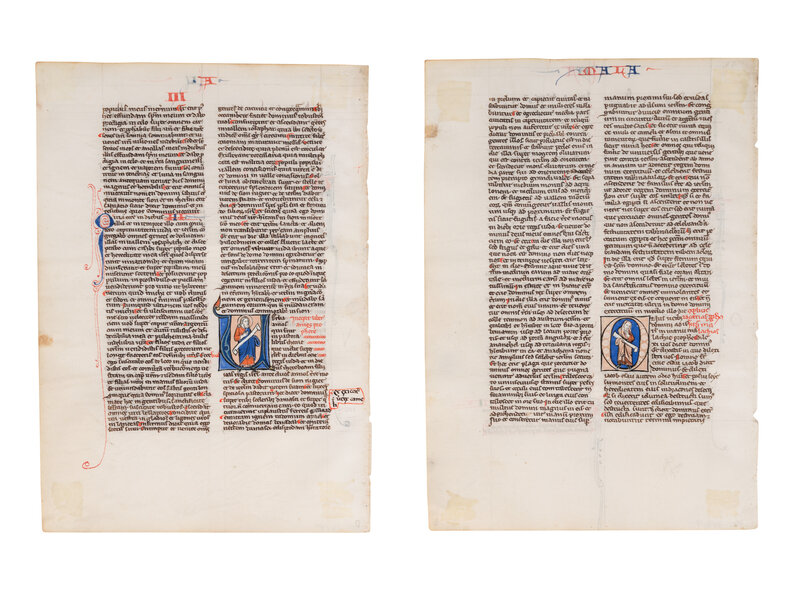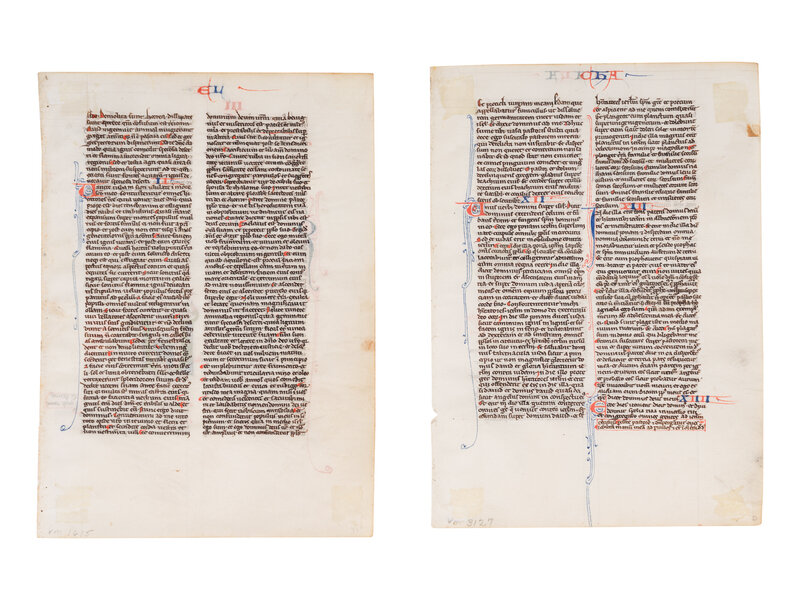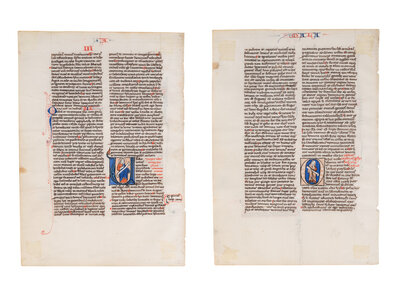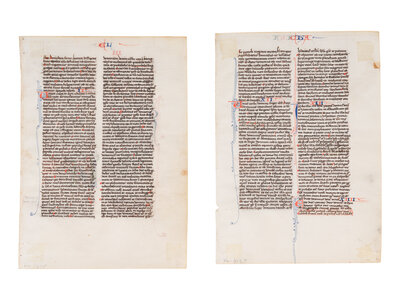Condition Report
Contact Information
Lot 14
ANONYMOUS FRENCH ILLUMINATOR
Two leaves from a Bible, with an historiated initial ‘U’ of Amos and an historiated initial ‘O’ of Malachi, in Latin, illuminated manuscript on parchment [France, Paris (?), c. 1225-1250]
Two leaves from a Bible, with an historiated initial ‘U’ of Amos and an historiated initial ‘O’ of Malachi, in Latin, illuminated manuscript on parchment [France, Paris (?), c. 1225-1250]
Sale 2033 - Western Manuscripts and Miniatures
Jun 27, 2024
10:00AM CT
Live / Chicago
Own a similar item?
Estimate
$4,000 -
5,000
Lot Description
ANONYMOUS FRENCH ILLUMINATOR
Two leaves from a Bible, with an historiated initial ‘U’ of Amos and an historiated initial ‘O’ of Malachi, in Latin, illuminated manuscript on parchment [France, Paris (?), c. 1225-1250]
Two leaves from a Bible, with an historiated initial ‘U’ of Amos and an historiated initial ‘O’ of Malachi, in Latin, illuminated manuscript on parchment [France, Paris (?), c. 1225-1250]
A remarkable pair of leaves, from the same early portable pocket Bible, with two historiated initials in a matching and fresh palette of lapis blue, white and red colors.
c. 146 x 105 mm. Two single leaves, modern foliation ‘351’ in pencil in the lower outer corner of the recto of the first leaf, another smudged by tape stain, ruled in plmmet for two columns of 52 lines (written space: c. 100 x 70 mm), with an extra rule in the top margin for the running titles, vertical bounding lines ruled full across, written below top line in light brown ink in a formal gothic book hand, two marginal corrections framed in red, versal initials touched with red, rubrics in red, running titles and chapter numbers alternately in red and blue, five two-line initials alternatively in red and blue with contrasting penwork extending into the margins, TWO NINE-LINE HISTORIATED INITIALS, one in dark blue with beige highlights on light pink ground, framed by lapis blue border decorated with white dots, another in light pink with white highlights on lapis blue ground, framed by light pink border (tape stains at the four corners, short slice of paper still taped to the upper left corner of the recto, remnant of an ancient bookmark in the outer edge, else in good condition).
These two leaves come from a well-documented thirteenth-century portable pocket Bible, a remarkable example of the type which began in the thirteenth century and quickly gained popularity partly among mendicant friars for their portability. The first leaf contains the end of Joel and the beginning of Amos, reading on the recto from Joel 1:17, “[Computruerunt jumenta in stercore] suo, demolita sunt horrea…,” to Amos 1:5 on the verso, “et disperdam habitatorem…” The beginning of Amos is introduced with a historiated initial ‘U’, for “Verba,” with Amos in full length holding a scroll and standing on light pink ground. The second leaf contains the end of Zachariah and the beginning of Malachi, reading on the recto from Zachariah 11:15, “Et præcidi virgam meam secundam…,” to Malachi 1:4 on the verso, “et vocabuntur termini impietatis…” The beginning of Malachi is introduced with a historiated initial ‘O’, for “Onus,” with Malachi in full length holding a scroll and standing on blue ground.
This is one of those Bibles that reveal some of the working methods of illuminators in the early generations of Paris as a major book-making center. During the early thirteenth century, production increased so dramatically that various techniques were developed and employed in order to make the process run more smoothly, often to ensure coordination between scribes on the one hand and illuminators on the other.
On the present leaves and their sister leaves, many guide-letters are provided by the scribe for the rubricator to indicate chapter numbers and sometimes also initials. In our case the scribe draws ink lines to the left of the text block to mark off spaces for the two initials. In the margin to the right of the initials, the scribe also wrote a large plummet ‘V’ and ‘O’, indicating the initials to be painted. Near most of the initials, someone, perhaps the scribe or stationer, drew simple sketches in the margins (too faint to be visible in reproductions), to indicate the intended iconography of the initials. A typical example is in the margin below Malachi: it shows a figure holding a book or scroll.
Provenance
(1) Fred Alpers (1930-1998), Chesterland, OH, no. 155; sold by him in September 1996 to:
(2) Sam Fogg, London, and acquired in September 1996 by:
(3) Robert McCarthy, London, MSS BM 1049, BM 1051.
Parent manuscript
The manuscript was described in 1948 before its dismantlement as containing a calendar, finely written in red, blue, and black, with the full text and 44 pages of indices, in a total of 632 leaves with about 250 historiated and ornamented initials and calligraphic decorations. It was probably made for a Dominican, as most pocket Bibles with calendars seem to have been made for mendicant friars, and in the light of the later provenance:
1. Owned by a Dominican by the 14th century, when “ordinis nostri” was added to the feast of St Dominic on 5 August in the calendar;
2. Heritage Book Shop, Los Angeles; acquired from them by:
3. Bruce P. Ferrini (1949-2010), Akron, OH, who broke it up by 1985.
Sister leaves
There are about 135 leaves at Ohio State University, including eleven with historiated initials; four are at the University of Colorado, Boulder, and a number of others can be recognized in various collections, including a further ten in the Robert McCarthy collection, published together with the present ones in his catalogue as no. 19 (see below).
LITERATURE
On the present leaves as well as their parent manuscript and sister leaves, published: Parke-Bernet Galleries, New York, 29-30 November 1948, lot 320; Phillip J. Pirages, Catalogue 12, no. 12; Bruce Ferrini Rare Books, Gothic Painting in Illuminated Manuscripts, Galleria Grafica, Tokyo, 1989, no. 3; Peter Kidd, The McCarthy Collection, Vol. III, French Miniatures, London, 2018, no. 19g, 19i, pp. 78-83 (with further literature).
We are grateful to Peter Kidd for permission to quote from his catalogue for this entry. Freeman’s | Hindman thank Senior Consultant Sandra Hindman and Elliott Adam for their assistance in preparing this sale.
The Collection of Robert McCarthy



